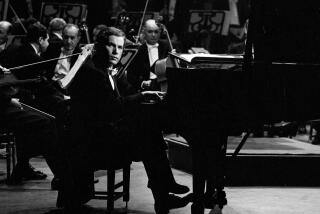O.C. JAZZ REVIEW : Gerald Wilson Plays His Kind of Music
NEWPORT BEACH — The Gerald Wilson Orchestra’s first set Friday at the Hyatt Newporter brought together tunes from some of the most distinguished names in music. Duke Ellington, Cole Porter, Erroll Garner and Miles Davis were all represented, as well as another composer, whose name may not be as well-known, but whose contribution to the jazz canon is still considerable.
The name of that composer? Gerald Wilson.
Beginning in the ‘40s, Wilson periodically wrote for Ellington’s orchestra in a relationship that continued until the bandleader died in 1974. He also penned material for Count Basie and Dizzy Gillespie (both of whom also utilized Wilson’s trumpet-playing abilities), and arranged numbers for a veritable Who’s Who of vocalists, a list that includes Billie Holiday, Dinah Washington, Ray Charles, Bobby Darin, Nancy Wilson and Little Jimmy Scott.
So it was appropriate that Wilson’s orchestra opened with an original from its leader, a blues number titled “You Better Believe It,” before moving on to those better-known names. The song’s presentation was typical of Wilson’s style of arranging and his stage presentation.
“I’m one of these guys who has a story about everything,” the 74-year-old bandleader told the Newporter audience. And he continued to relate how he had sold “Believe It” on about 20 occasions. “I changed the name every time,” he added slyly.
The piece began with just the rhythm section, pianist Brian O’Rourke creating lavish chordal passages that hinted at the lush orchestration to come. Then the horns kicked in, the trumpets trading theme lines with the trombones and saxes, before all joined together in an upbeat send-off into solo time. During it all, Wilson actively conducted with sweeping gestures and pointed directions.
A number of instrumentalists took turns standing up to strut their stuff during the number. The performances included an angular alto sax outing from Danny House, a melodic workout from trombonist Ira Nepus, exciting tenor work from Louis Taylor and a considered, yet swinging one-note-at-a-time guitar passage from Anthony Wilson (no relation).
Then, with the band still playing, Wilson turned to the audience and explained the final ensemble passage, with its balance of quiet and loud sections.
“And,” he added immodestly, “I’ve put all the notes in the right places.”
From there he took the band out.
Tenor saxophonist Carl Randall was featured on “Sophisticated Lady,” and he sometimes played teasingly behind the beat while the horns whipped up splashy ensemble passages behind him. Porter’s “Love For Sale” was given a mid-tempo treatment, this time with guitarist Wilson leading the way into the tune.
The bandleader told how Miles Davis had virtually abandoned what was to become his signature tune of the early ‘60s, “Milestones,” until the trumpeter came in and heard Wilson’s arrangement played by the orchestra. Here, the tune featured a very unlike-Miles trumpet solo from Bob Summers, who instead generated excitement with fast, clean tones while drummer Mel Lee colored the excursion with cymbal shading.
The one common thread running through all the pieces (“Misty” and “Who Can I Turn To?” were also aired) was Wilson’s arranging style, a sophisticated approach that finds familiar numbers framed by rhythm section-only passages with an array of instrumental combinations and dynamic levels.
It’s this kind of music that continues to underscore Gerald Wilson’s standing as a musical treasure.
More to Read
The biggest entertainment stories
Get our big stories about Hollywood, film, television, music, arts, culture and more right in your inbox as soon as they publish.
You may occasionally receive promotional content from the Los Angeles Times.










